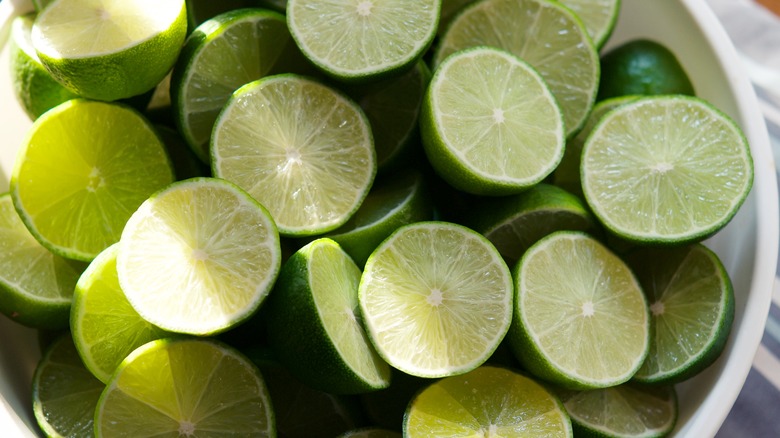Why You Might Want To Think Twice Before Cooking Outdoors With Limes This Summer
As refreshing as it feels to have a snack in the sunshine, there are safety precautions for foods like ceviche and key lime pie — anything containing lime juice, really. If you're sad and confused, you aren't alone. Limes are one of many plant varieties that contain the natural chemical, furanocoumarin. Inside furanocoumarin is psoralen. This chemical aids plants in the defense against microorganisms, nematodes, and phytophagous insects. This is lovely for the plant, but for humans, psoralen can cause more harm than good.
When lime juice comes into contact with human skin under UV rays, psoralen can cause an intense skin reaction called phytophotodermatitis. This reaction can happen anywhere lime juice has been absorbed into the skin. For that reason, it's common to experience it on hands or around the mouth. It can occur from foods like guacamole which have lime juice mixed in, but it's more likely to happen from lime juice directly.
The symptoms of phytophotodermatitis aren't pleasant and include blisters, skin rashes, peeling skin, red skin, swelling, and post-inflammatory hyperpigmentation, which sometimes leads to skin discoloration that lasts long after the initial condition. Some people are more likely to experience phytophotodermatitis than others like gardeners, hikers, children who play outside often, and bartenders, due to their frequent exposure to limes.
How to prevent phytophotodermatitis
When it's warm outside, it feels like certain foods can cool you down. But before you proudly juice the best limes you can find in the grocery store while sitting on the porch, you might want to think again. You can prevent phytophotodermatitis by avoiding contact with lime juice or washing your hands and any areas of your skin which were exposed to lime juice. It isn't just limes that can cause phytophotodermatitis, though. Celery, figs, and parsnips carry the same chemical that leads to the condition. If you're working with citrus for a long time, remember that it takes between 30 and 120 minutes for the psoralen to fully absorb into your skin, so wash your hands accordingly.
When you're outdoors, make sure to protect your skin against UV exposure with proper clothing and sunscreen. This is important whether it's sunny or cloudy as UV rays in the form of sunlight can still impact skin even if it's a cloudy day. If you develop phytophotodermatitis, seek help from a medical professional to properly treat the affected area and mitigate the damage.

